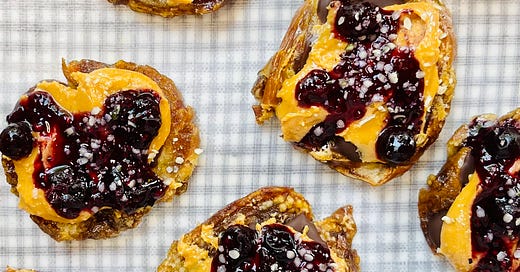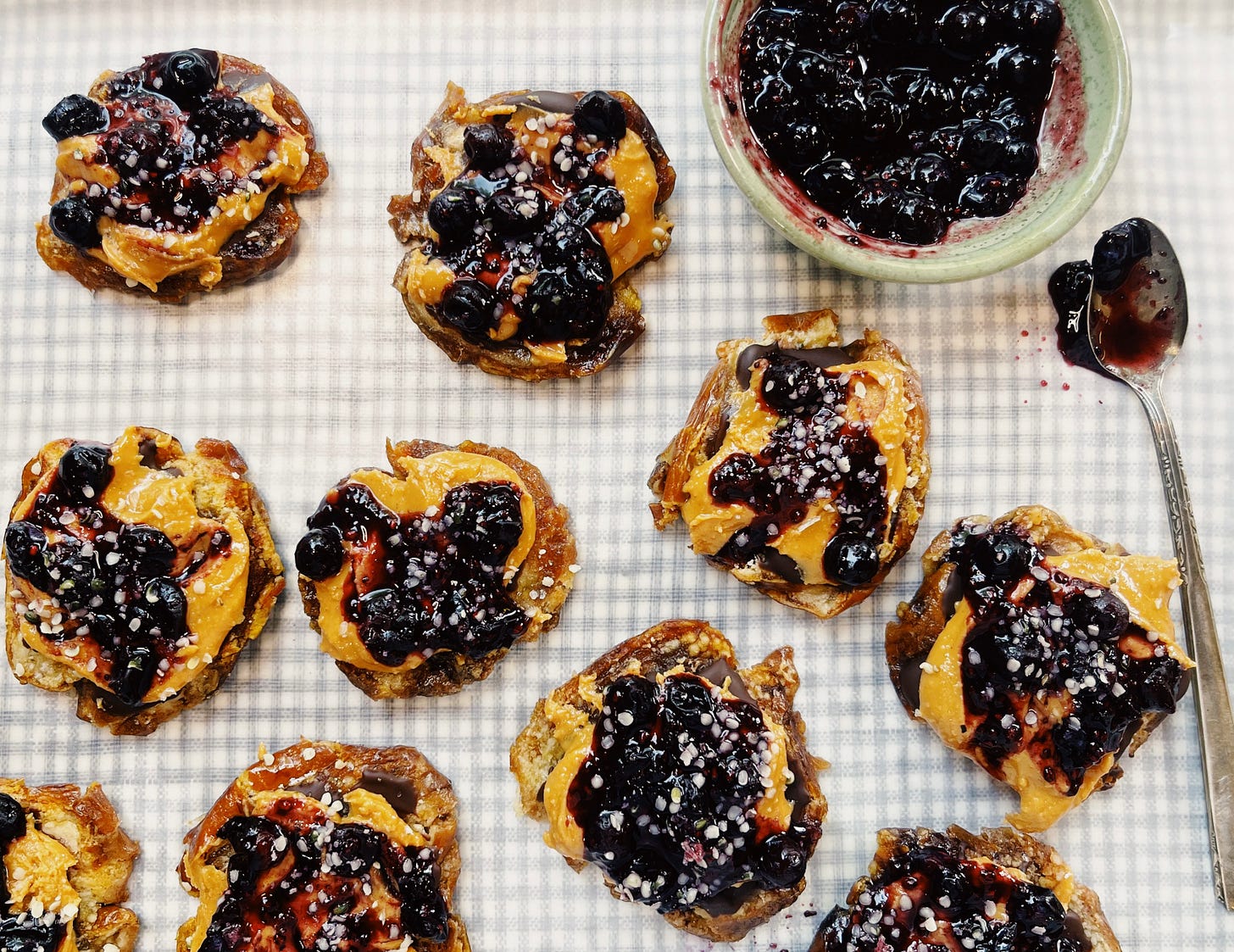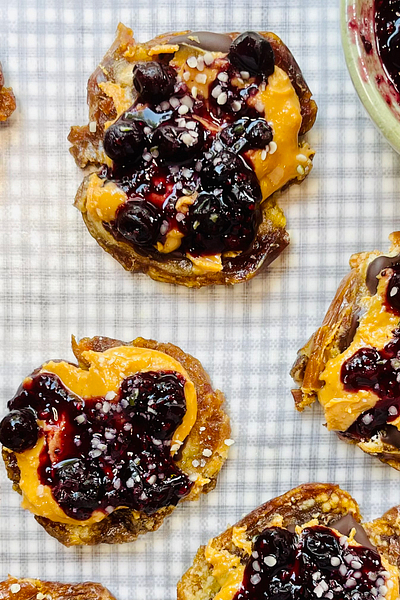Wild Blueberry and Peanut Butter Turtle Dates
Plus, how flavanol-rich foods (like berries!) protect the memory center of the brain, according to a new study
Hello, everyone. It’s a drizzly morning here in Jackson Hole, a scenario that always sends me right into the kitchen to cook. I am making another batch of my NEW Wild Blueberry and Peanut Butter Turtle Dates, a fabulous treat that I can’t wait for you to try (recipe below). I’m also prepping ahead for Father’s Day dinner this Sunday. We’re having two BHK book recipes from this month’s Cookbook Club menu: Tuna Burgers with Wasabi Mayo and Mango Salad and the irresistible Coffee, Date, and Oat Bars. But first, I am excited to share a new study about how the flavanols in food target the memory center of the brain.
Flavonoids: The Colorful Brain Health Nutrients
Readers of this newsletter are well-acquainted with flavonoids—those bioactive substances in colorful plant foods emerging as key players in protecting the brain. If you are new here (hello! welcome!), you can get up to speed by reading this article about the 4F’s and this one about cocoa flavanols and brain health.
Here’s a Brief Recap of What We Know About Flavonoids:
More than 5,000 different flavonoids have been described; the health-promoting ones fall into these five subclasses: flavanols, flavones, flavanones, flavan-3-ols, and anthocyanidins.
Flavanol supplements are often used in nutrition intervention studies. I reviewed the larger studies, like CoCoA, COSMOS, and COSMOS-MIND here.
Eating flavanol-rich foods significantly reduces the risk of Alzheimer’s by about half.
Flavanol-rich foods boost 4 aspects of cognitive health: semantic memory, episodic memory, visuospatial ability, and processing speed, which helps achieve better brain function now and build stronger memory for later years.
Now a new study published last month adds to our knowledge of how flavanols impact cognitive aging—the type of memory decline secondary to brain aging, but not necessarily due to a neurodegenerative disease, such as Alzheimer's or Parkinson's. The Cocoa Supplement and Multivitamin Outcomes Study-Web (COSMOS-Web) followed over 3500 healthy (dementia-free) older men and women for one year. The participants were randomly assigned to receive a flavanol-containing cocoa extract (500 mg of cocoa flavanols, including 80 mg of epicatechin) or a placebo daily. Researchers were looking to see if the flavanols made a difference in certain memory tests after one full year.
As expected, the flavanol group did better on memory tests compared to the placebo group. When researchers focused on the group of participants with the lowest memory scores at the onset of the study, something amazing happened. As their flavanol levels went up—which they determined by checking for flavanol metabolites in the urine—so did their memory function.
This was the first study to show flavanol supplementation can restore memory in those with a flavanol-deficient diet. And, it does so by targeting the dentate gyrus, a brain region within the hippocampus, the memory center of the brain.
Currently, there is no recommended dietary allowance (RDA) for flavanols like there is for other nutrients, such as B vitamins and vitamin D. Based on this study and many others that came before it, brain health experts are now talking about whether flavanols should have its own RDA and be included in other standardized dietary recommendations for healthy aging. Taking a flavanol supplement may become as common as taking vitamin D.
The Bottom Line: Eating flavonoid-rich foods is still the best way to make sure you are getting enough of this crucial brain health nutrient. Flavanol supplementation may help restore memory in those with flavonoid-deficient diets.
My top flavonoid foods are: apples, pears, olive oil, figs, leafy greens, soy foods, green tea, citrus, coffee, red onions, dark chocolate, whole grains (quinoa and oats), colorful beans and lentils, and berries.
Wild Blueberries Star in My New Peanut Butter Turtle Dates
Berries are famously good for the brain thanks to their flavonoid content. In fact, berries are one of the best food sources of anthocyanins—a type of flavonoid found to be especially good for memory. I recommend eating a wide variety of berries in your brain-healthy dietary pattern. But I also want you to include the most potent ones, aka wild blueberries.
Wild blueberries have 33% more anthocyanins than other berries. That’s because the memory-boosting bioactives reside in the skin and these small berries have a greater skin-to-flesh ratio. And, just like some types of green tea that are cultivated to boost polyphenols, wild blueberry farmers pay careful attention to growing practices that boost anthocyanins. If you’re curious to dive deeper into the robust data linking wild blueberry intake to brain health, the Wild Blueberry Association of North America (WBANA) website has a list of pertinent research here.
For all these reasons (plus how delicious they are!), I am always looking for ways to incorporate these nutrient-dense berries into my recipes. So when my friends at WBANA reached out to me to create a new treat using wild blueberries for Alzheimer’s and Brain Awareness Month, I started dreaming of a two-bite date packed with fiber and protein, and the sweet tart deliciousness of these special berries. Hence, the Wild Blueberry and Peanut Butter Turtle Dates were born.
Recipe: Wild Blueberry and Peanut Butter Turtle Dates
If you grew up in the ’60s and ‘70s, like I did, you may recall Goober—a jar of peanut butter swirled with Smucker’s grape jam. This would be at the top of my list of junky ultra-processed foods to avoid, but I’m reinventing it here by swirling mashed wild blueberries into good-quality natural peanut butter. The result: A fun riff on the PB&J that just happens to be brimming with fiber, protein, and anthocyanins. This recipe gives you a bit more wild blueberry “jam” than you need to top the turtles. Save it to swirl into oats or spread on whole grain toast.
Tip: Find wild blueberries in the frozen food section of the grocery store. If the package says “wild,” they are the ones cultivated in Maine and Canada to be anthocyanin-rich.
Makes 10
Ingredients:
½ cup frozen wild blueberries
1 teaspoon chia seeds
2 ounces dark chocolate, 70% or greater cacao, chopped or ⅓ cup dark chocolate chips
1 teaspoon extra-virgin olive oil plus more for pressing the dates
10 large, soft unpitted Medjool dates
1 tablespoon peanut butter, almond butter, or other nut or seed butter (see Note)
Hemp seeds, for sprinkling
Flaky sea salt, for sprinkling (optional)
Instructions:
Microwave the wild blueberries on low for 30 seconds or leave at room temperature until partially defrosted. Gently mash with a spoon, keeping most of the berries whole. Stir in the chia seeds and set aside until the “jam” thickens, about 10 minutes.
Microwave the chocolate in 15 second intervals until mostly melted. (Alternatively, place the chocolate in a heat-proof bowl over a pot of boiling water, making sure the water doesn’t touch the bottom of the bowl. Stir until melted.) Stir in 1 teaspoon olive oil until smooth. Set aside.
Line a rimmed baking sheet with parchment or wax paper. Brush with oil. Slice open the top of each date lengthwise, open like a book, and remove the pit. Place them open-side-up on the baking sheet.
Coat your fingers with olive oil and press each date into a flat round. Spray or brush the bottom of a cup with oil and use the flat bottom and gently press each date flat. Shape the dates into rounds with your fingers.
Spread 1 teaspoon chocolate mixture evenly atop each date. Freeze until firm, about 10 minutes.
Spoon ½ to 1 teaspoon peanut butter atop each date and spread to the edges in an even layer. (If your dates are very large, you’ll use a whole teaspoon.) Place ½ teaspoon wild blueberry “jam” in the center and use the tip of a knife to swirl gently. Sprinkle each with a pinch of hemp seeds and salt, if using.
Freeze until firm, about 10 minutes. Enjoy right away, cold from the freezer, or partially frozen (my favorite!). Store in a single layer in an airtight container in the freezer for up to 3 months.
Note: Look for nut and seed butters with no added sugars or oils. Food companies add unhealthy oils, such as soybean and palm oil, to nut butters to give them a spreadable consistency. Avoid these no-stir brands. The best nut butters will require a bit of stirring because the nuts’ natural oils (full of brain-friendly fats) naturally separate in the jar. My current favorite peanut butter has a short ingredient list, just lightly roasted peanuts and less than 1% salt.
Father’s Day is This Weekend
Father’s Day always comes right on the heels of my dad’s birthday. Growing up, it was a week-long celebration of my dad and his favorite foods! These would include meatballs, shrimp cocktail, iceberg wedge salad with blue cheese dressing, strawberry shortcake, and the Chocolate Pecan Sheet Cake my mom made every June to span both special days. If my dad was still with us, he’d be 102. A devotee to the PB&J, I think he’d like these Turtle Dates very much.
Cheers to all the dads out there on your special day! And I’m sending warm thoughts to all of you, like me, who are missing their dads like crazy.
Love,
Annie







I made the dates this weekend and they’re delicious! Thank you for the great recipe.
Really appreciated this article on flavenoids!